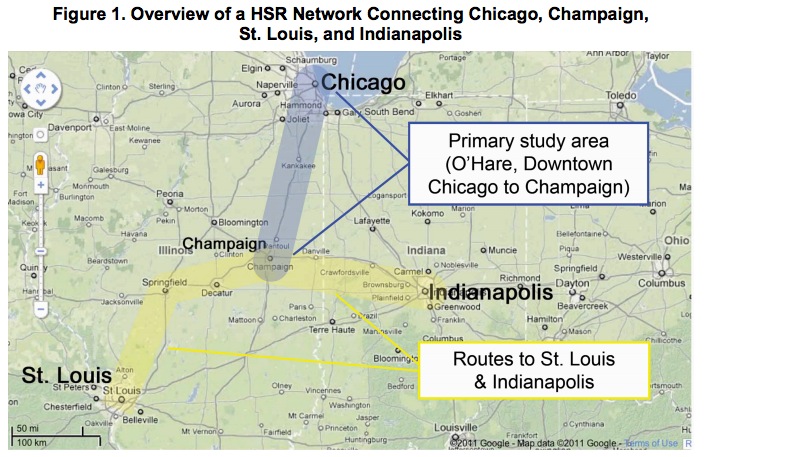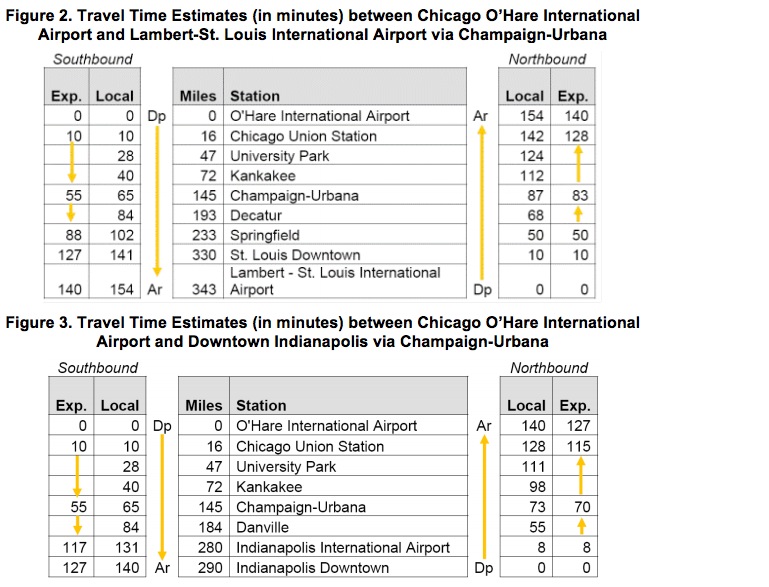ILLINOIS DEPARTMENT OF TRANSPORTATION
1. Introduction
In 2009, the U.S. Department of Transportation (U.S. DOT) unveiled a high speed rail vision for America that would complement existing transportation systems (e.g. highways, aviation, and regional and urban public transportation systems). These systems would span between 100 and 600 miles to safely, conveniently, and efficiently connect communities across America. They would create a foundation for economic growth in a more complex global economy, promote energy independence, improve safety and environmental quality, and foster livable communities. The U.S. DOT envisioned collaboration with the states to help plan and develop high speed rail in intercity passenger rail corridors.
Governor Quinn shares this vision. His administration and IDOT have worked to bring 110-mph high speed rail service from Chicago to St. Louis via Springfield. This service currently exists between Dwight and Pontiac and will extensively grow from Dwight to Alton in 2015. It will continue northward to Joliet in 2017.
Governor Quinn shares this vision. His administration and IDOT have worked to bring 110-mph high speed rail service from Chicago to St. Louis via Springfield. This service currently exists between Dwight and Pontiac and will extensively grow from Dwight to Alton in 2015. It will continue northward to Joliet in 2017.
IDOT sponsored a research team at the University of Illinois, including the Urbana-Champaign and Chicago Campuses, to study the feasibility of such a project, including engineering, operational, ridership, economic and financial aspects.
2. Overview of the Study Area
The study area as shown in Figure 1 involves approximately 10-mile-wide corridors running roughly north-south between Chicago O’Hare International Airport, downtown Chicago, and Champaign, and then east-west from Champaign to St. Louis and Champaign to Indianapolis. The total length of all corridors is approximately 500 miles, mostly in Illinois, with portions of the corridors extending into Missouri and Indiana.
The study area as shown in Figure 1 involves approximately 10-mile-wide corridors running roughly north-south between Chicago O’Hare International Airport, downtown Chicago, and Champaign, and then east-west from Champaign to St. Louis and Champaign to Indianapolis. The total length of all corridors is approximately 500 miles, mostly in Illinois, with portions of the corridors
extending into Missouri and Indiana.
Any selected alignment in the future is envisioned to have two dedicated, electrified main tracks with an 18-foot track center distance fully grade separated from the other transportation modes. The study team did not assess whether existing rights-of-way could accommodate additional high speed rail tracks or the potential implications of 220 mph service on existing railroad operations. Future refinements of high speed rail alignments near existing railroads will need to carefully consider the railroads’ rights-of-way, safety, and operating requirements.
3. Travel Times
Electrified trains with steel-wheel-on-steel-rail technology would use this line. Consistent with current international practice, they would be designed for speeds up to 250 mph, but would generally travel at a maximum speed of 220 mph. They would operate at somewhat lower speeds where there were physical or infrastructure design constraints.
Express high-speed rail trains would take about 45 minutes to travel from downtown Chicago to Champaign; 1 hour 18 minutes to Springfield; and approximately 2 hours to either downtown St. Louis or Indianapolis. They would likely run every half-hour during peak times and hourly at other times. Figure 2 shows the express and local travel time estimates between O’Hare Airport in Chicago and Lambert-St. Louis International Airport via Champaign. Figure 3 shows the express and local travel time estimates between O’Hare Airport in Chicago and Downtown Indianapolis via Champaign.
Download Executive Summary (PDF): 220 MPH High Speed Rail Preliminary Feasibility Study
Download Executive Report (PDF)
About the Illinois Department of Transportation
www.dot.state.il.us
“The mission of IDOT is to provide safe, cost-effective transportation for Illinois in ways that enhance quality of life, promote economic prosperity, and demonstrate respect for our environment.”
Tags: Chicago, CHSR, HSR, IDOT, IL, Illinois Department of Transportation, Missouri, Springfield, University of Illinois, Urbana-Champaign








 RSS Feed
RSS Feed